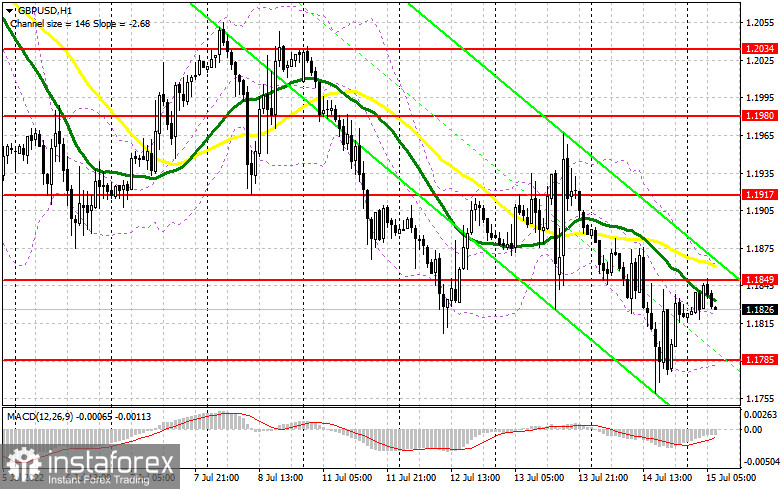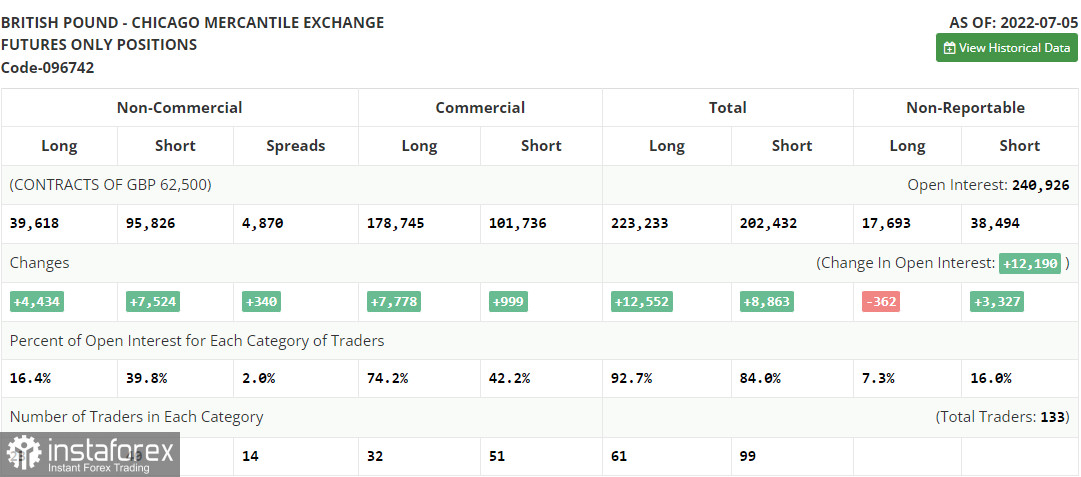Several market entry signals were formed yesterday. Let's take a look at the 5-minute chart and see what happened. I paid attention to the 1.1831 level in my morning forecast and advised making decisions on entering the market from it. The pound's decline and forming a false breakout at 1.1831 led to an excellent entry point into long positions, which I described in detail in my forecast for the European session. As a result, the pair rose by more than 40 points, but we did not reach the target resistance of 1.1887, so that we could enter short positions. A breakthrough and reverse test of 1.1811 in the afternoon gave an excellent signal to sell the pound further along the trend, which led to a sharp 50-point move down.

When to go long on GBP/USD:
Pound bulls chose the annual low yesterday and are now clearly aiming for a continuation of the upward correction at the end of the week. But for this you need to try very hard, because without a breakdown of the resistance of 1.1849, it is unlikely that anything will be done seriously. The same goes for moving averages, limiting the pair's upward potential. Considering that there are no important statistics on the UK today, the bulls will have a chance to go beyond this range, but only a reverse test from top to bottom of this level will give a signal to open long positions with the goal of recovering to the 1.1917 area, where I recommend taking profits. A more distant target will be the area of 1.1980, the test of which will seriously affect the bear market, pulling the pair into a wide horizontal channel. In case the pound falls, in my opinion, bulls will be active only in the area of the nearest support of 1.1785, where they will try to build the lower border of a new rising channel in an attempt to find the bottom of the market.
In case GBP/USD falls and there are no bulls at 1.1785, and it is quite possible that this will happen, considering what a bear market we are in, I recommend postponing long positions to the next annual low of 1.1707. I advise you to buy there only on a false breakout. You can open long positions on GBP/USD immediately for a rebound from 1.1643, or even lower - around 1.1575, counting on correcting 30-35 points within the day.
When to go short on GBP/USD:
The bears' main task for the day is to protect the important resistance at 1.1849, which has already been tested during the Asian session. Taking into account the recent data on inflation in the US and the continued demand for the dollar, we can expect another breakthrough of the pound to the annual low, but whether it will be possible to update them is a big question. The optimal scenario for opening short positions will be forming a false breakout at 1.1849, where the moving averages are, which will increase pressure on the pair in order to pull it to a rather important support at 1.1785. If the bulls are not active there and consolidating below, the reverse test from the bottom up will provide an additional entry point for selling the pound with a decrease to 1.1707, where I recommend partially taking profits. A more distant target will be the area of 1.1643, the test of which will be evidence of the continuation of the downward trend.
In case GBP/USD grows and the bears are not active at 1.1849, although the situation will not change in the direction of bulls, it will be possible to see a more significant upward correction. In this case, I advise you not to rush into short positions. Only a false breakout in the area of the next resistance at 1.1917 will provide an entry point to short positions, counting on the pair's bounce to the downside. If there is no activity there, another upsurge may occur amid the removal of speculative sellers' stop orders. In this case, I advise you to postpone short positions until 1.1980, where you can sell GBP/USD immediately for a rebound, based on a rebound of the pair down by 30-35 points within the day.

COT report:
An increase in both short and long positions was recorded in the Commitment of Traders (COT) report for July 5, but the former turned out to be much larger, which led to an increase in negative delta. Another attempt to buy out the annual low failed after it became obvious that the Bank of England intends to continue to fight inflation by raising interest rates, which will definitely slow down the British economy even more and push it into recession. The crisis in the cost of living in the UK continues to flare up more and more, and the recent resignation of British Prime Minister Boris Johnson is unlikely to help quickly deal with this. There are no prerequisites for buying the British pound, except for the fact that it has updated the next annual lows. The policy of the Federal Reserve and its pace of raising interest rates in the US gives the dollar much more support, since there are no such problems with the economy. This was confirmed by recent data on the US labor market for June this year. The COT report indicated that long non-commercial positions rose by 4,434 to 39,618, while short non-commercial positions jumped by 7,524 to 95,826, which led to an increase in the negative value of the non-commercial net position to -56,208 from level -53,118. The weekly closing price decreased and amounted to 1.1965 against 1.2201.

Indicator signals:
Moving averages
Trading is conducted below the 30 and 50-day moving averages, which indicates the pound's succeeding downward movement.
Note: The period and prices of moving averages are considered by the author on the H1 hourly chart and differs from the general definition of the classic daily moving averages on the daily D1 chart.
Bollinger Bands
In case of growth, the area of 1.1875 will act as resistance. In case the pair goes down, the lower border of the indicator around 1.1785 will act as support.
Description of indicators
- Moving average (moving average, determines the current trend by smoothing out volatility and noise). Period 50. It is marked in yellow on the chart.
- Moving average (moving average, determines the current trend by smoothing out volatility and noise). Period 30. It is marked in green on the chart.
- MACD indicator (Moving Average Convergence/Divergence — convergence/divergence of moving averages) Quick EMA period 12. Slow EMA period to 26. SMA period 9
- Bollinger Bands (Bollinger Bands). Period 20
- Non-commercial speculative traders, such as individual traders, hedge funds, and large institutions that use the futures market for speculative purposes and meet certain requirements.
- Long non-commercial positions represent the total long open position of non-commercial traders.
- Short non-commercial positions represent the total short open position of non-commercial traders.
- Total non-commercial net position is the difference between short and long positions of non-commercial traders.





















